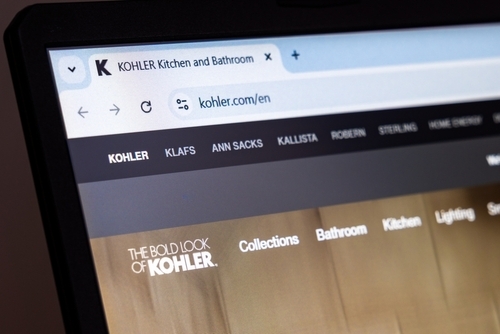Numerous, updated and consistent images across channels goes a long way for boosting conversion, said Connor Bennett, Associate Channel Manager at Kohler Co.
The kitchen and bath manufacturer sells its products on seven home furnishings and improvement marketplaces, including on The Home Depot, Lowe’s, Wayfair, Ace Hardware, Amazon, Menards and Costco.
And it’s important to keep those listing pages as consistent as possible from website to website in order to maintain the quality of how its brand is presented to shoppers, Bennett said.
“Being able to have the top-of-the-line images and being able to accurately show what our finishes look like, how a product functions and all the features of it, that is everything,” he said.
The manufacturer is currently in the process of updating all of its images and content across all channels to ensure quality and consistency.
The project comes with a hefty reward: better conversion. For the categories it’s finished, those products have received a “big bump” in conversion, said Bennett, who declined to reveal the exact increase.
One reason for the increased conversion could be because the images more accurately reflect the products, its finishes and technology.
Some product detail pages are getting a major upgrade, as Kohler hasn’t updated them in decades. Bennett gave the example of a tub Kohler has sold for the past 50 years. It only had a basic image and then an image of it in a generic bathroom.
“What we found with a lot of our older products is they just don’t have the quality that we’re looking for,” he said.
Kohler Finds the Right Number and Type of Images for Each Product
On average, Kohler is aiming for 12-15 images per product. It varies by category, such as shower doors needing up to 17 images to showcase its features, whereas a shower pan would only need seven to 10 images.
Kohler also dedicates images to highlighting a product’s features, showing comparisons to other products and maintenance tips. For example, for one of its sinks, a feature is a deep basin. A few images into the carousel Kohler shows one image that displays “Deep Basin” as a headline, with text overlay of four reasons why a deep basin is advantageous. Plus, Kohler shows the the sink loaded with dishes with a ruler next to it.
Kohler knows a consumer may not scroll down and read every detail about the product and by placing informative images in the carousel puts those details right in front of shoppers.
“If you’re going for one of the top products that we have, it might be a couple hundred to thousands of dollars purchase,” Bennett said. “We don’t want to have that return; We don’t want to have an issue with installation. We don’t want to have anybody regretting that purchase because of our brand presence and we want our name to always be associated with the top of the line.”
But — for the shoppers who do scroll — that below-the-fold content is another key area Kohler is working to improve. With so many products on the market, the information further down the page can help sell shoppers.
“You want to be able to differentiate yourself between why you should be going with us over our competitors and below-the-fold is a good way to be able to give that extra information,” he said.
Using Humans Takes Time but It’s Worth It
Kohler has worked on the project for about half a year and it will likely take another year until it’s complete.
Opposed to using generative artificial intelligence, Kohler is using humans to create digital renderings of the product with generic set pieces. This also will help ensure consistency going forward, as it doesn’t have to create an identical set every time it adds a product.
“We want to have control of somebody doing that as opposed to having a computer generate it and those images just aren’t as good as we want them to be,” Bennett said.




